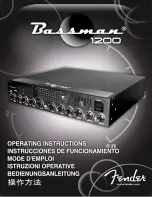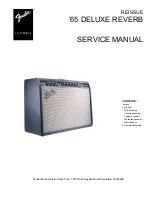
CALIFORNIA BLONDE OWNER’S MANUAL •
55
is fully clockwise, no dry or unaffected signal is heard other than the output of your effects device.
This type of control and patching arrangement is very effective in reducing noise caused by effects units and in
maintaining a more natural sound. If your effects device has a similar control, we suggest leaving it set to its max-
imum effect/minimum dry signal position and using the
Effects Blend
control for this function. Please read the
“Effects Loop” section for more information.
MIC/AUXILIARY CHANNEL (Ch. 2)
TUNER OUT
This feature allows the user to connect their instrument tuner to the California Blonde without having to unplug and
go back and forth from amp to tuner to amp. The Tuner Out circuit is isolated from the rest of the circuitry and no
other controls other than your instrument affect the signal. Being on a side chain (isolated) also avoids loading
down of the instrument which can cause a loss in dynamic range.
To use the Tuner Out, plug in a shielded patch cord from this jack to the INPUT of your tuning device. Turn the
amp on and you’re ready to go. If you don’t want to monitor your sound while tuning, turn down either the
Gain
or
Master Volume,
or position the
Speaker On/Off
switch on the back panel to the “Off” position.
BALANCED MIC INPUT
This input is a true balanced XLR input, not a single-ended input as on some amplifiers. This input is DISCONNECTED
when the Stereo Input is being used. Input impedance is 10k ohms, and the wiring is American standard:
Pin 1= ground, Pin 2= +, Pin 3= – (minus)
The Balanced Mic input does not supply phantom power. Phantom power can be obtained by the use of an
outboard phantom power supply box, available at most large musical instrument retailers.
AUXILIARY INPUT (AUX IN)
This input can be used with a second instrument, unbalanced microphone, or any source not needing a super
high input impedance. Input impedance is approximately 800k ohms. This input will not function when the Stereo
Input is being used.
GAIN, PULL PHASE, BASS, MID RANGE, TREBLE & EFFECTS BLEND
Since these features are all identical to the ones found in the Instrument channel, please refer to that section for
proper operation and information.
MASTER SECTION
MASTER SECTION
MASTER VOLUME
The
Master Volume
control adjusts the signal level going to the power amplifier, stereo headphones jack, exten-
sion speaker and the internal speaker system. It does NOT affect the Balanced XLR Line out. For optimum signal-
to-noise ratio, it should be used in conjunction with the Gain control.
MASTER REVERB
The
Master Reverb
control blends in the reverb with the main signal. The reverb circuitry is on a side chain as
well, so the natural sound of your instrument is always maintained. Rotating this control clockwise will add more
reverb to the overall sound. Reverb is introduced after the Instrument and Mic/Aux channels have been summed
together and will affect both channels (unless you utilize the
Post-Reverb Return
jack, which is explained later
in the “Rear Panel Features” section).
REAR PANEL FEATURES
REAR PANEL FEATURES
STEREO HEADPHONES JACK
By inserting a set of stereo headphones into this jack you will be able to monitor your sound or practice without
disturbing your neighbors. The volume level is adjusted by the
Master Volume
. We suggest you begin with the
Master Volume
off (fully counter-clockwise), then slowly bring the volume up to your desired level. If you hear
some distortion in your headphones that is not present with the speakers on, turn down the volume—you are






























